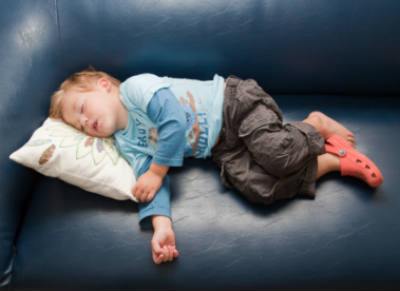Some preschool programs are starting to eliminate naps. That’s because they want to prepare the children for kindergarten, where daytime naps no longer take place. But, what about when your child isn’t in school? How can you tell if he or she still needs to take a nap? 
Akron Children’s Hospital comes down in the pro-nap camp, sharing why preschool-aged kids typically need one. “Crucial physical and mental development occurs in early childhood,” their article says, “and naps provide much-needed downtime for growth and rejuvenation.”
Most preschoolers get between 10 to 12 hours of sleep at night–and then still need more rest, in part because of how active they usually are. And, although parents might worry that a daytime nap will make it more challenging for their young children to fall asleep at night, naps actually keep children from being overtired. Why is that important? Because being overtired can make it more difficult for children to fall asleep at bedtime!
Here’s another plus about naps. If your child doesn’t fall asleep during naptime, at least he or she is getting some quiet time. If that quiet time leads to sleep, that’s good. If not, there is value in the quiet time all by itself, even if your child looks at a book in bed.
Conflicting Evidence?
In 2015, a paper published in the Archives of Disease in Childhood journal called the value of daytime naps into question. This research suggested naps taken by children older than two years of age might interfere with overall sleep quality. So, what’s the right answer? Do preschoolers still need naps–or not?
The Washington Post tackled the question, pointing out how the paper called the “treasured practice of toddler napping” into question–and then suggested that parents “forget about the good/bad distinction” of daytime naps and, instead, determine what’s best for their specific child.
The article suggests you monitor how many hours of sleep your child is getting in a 24-hour period. Then check those hours against the National Sleep Foundation’s recommendations, which were updated a few years ago. What’s most important is a solid night of sleep (10-13 hours for a preschooler) and, if your child is getting all the rest he or she needs, the nap may no longer be necessary.
How can you tell, though, if your child is really getting enough rest for his or her individual needs? By behavior! Tired children, the article points out, are “moody, hyperactive or have trouble focusing.”
Most children, according to Parents.com, give up naps between the ages of three to five. Signs that it’s time to ditch the daytime siesta include when your child:
- starts to have trouble falling asleep at the regular bedtime; this may indicate that the nap is providing him or her with too many hours of sleep
- fusses about naps more than usual
- maintains a relatively stable mood without the nap, with enough energy to get through the day
- wakes up on his or her own in the morning in a good mood
If, though, your child still falls asleep easily, at naptime and at night, he or she probably still needs a daytime nap. If your child gets fussy around naptime or shows tiredness through body language, those are additional signs naps still have value. Or, your child might go into hyperdrive right around naptime, which indicates overtiredness.
Still not sure if your preschooler still needs a nap? Replace the idea of napping with afternoon quiet time and let your child transition according to his or her unique needs.




